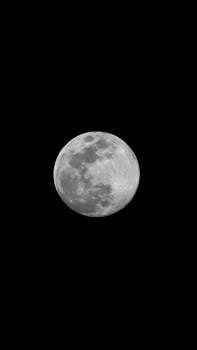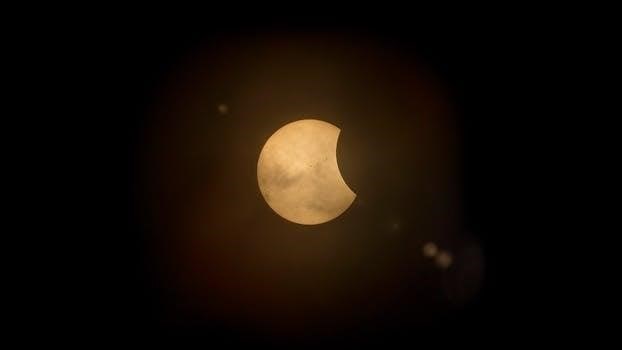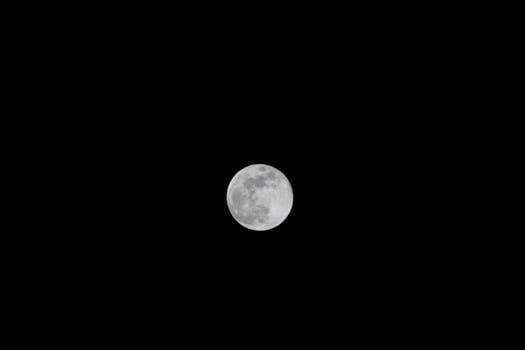Solar and Lunar Eclipses⁚ Worksheet Focus
Solar and lunar eclipse worksheets are valuable tools for exploring these celestial events. These worksheets can have engaging word searches and puzzles. Worksheets also model the movements of the Earth, Sun, and Moon, relative to each other during eclipses. Worksheets may include eclipse diagrams.
Understanding Solar Eclipses
Solar eclipses are captivating events that occur when the Moon passes between the Sun and Earth, casting a shadow and temporarily blocking sunlight. These eclipses are a result of a celestial alignment where the Sun, Moon, and Earth are positioned in a straight line. During a solar eclipse, the Moon obscures the Sun, creating a shadow on Earth.
There are different types of solar eclipses, including total, partial, and annular eclipses. A total solar eclipse occurs when the Moon completely blocks the Sun, resulting in a breathtaking sight. A partial solar eclipse happens when the Moon only partially covers the Sun. An annular eclipse occurs when the Moon is farther from Earth, appearing smaller and leaving a bright ring of sunlight visible around the Moon’s edge.
Understanding solar eclipses involves learning about their formation, types, and the importance of safe viewing practices. It is crucial to never look directly at the Sun during a solar eclipse without proper eye protection, as it can cause severe eye damage.

Understanding Lunar Eclipses
Lunar eclipses are stunning celestial events that occur when the Earth passes between the Sun and Moon, casting a shadow on the Moon’s surface. During a lunar eclipse, the Earth blocks sunlight from reaching the Moon, causing it to appear dim and reddish. Lunar eclipses can only occur during the full moon phase.
There are different types of lunar eclipses, including total, partial, and penumbral eclipses. A total lunar eclipse happens when the Moon passes entirely through the Earth’s umbra, the darkest part of its shadow. A partial lunar eclipse occurs when only a portion of the Moon passes through the Earth’s umbra. A penumbral lunar eclipse happens when the Moon passes through the Earth’s penumbra, the fainter outer part of its shadow.
The Moon can appear various shades of red, orange, or brown during a total lunar eclipse due to the scattering of sunlight through Earth’s atmosphere. Unlike solar eclipses, lunar eclipses are safe to view with the naked eye, making them a popular astronomical event.
Similarities Between Solar and Lunar Eclipses
Solar and lunar eclipses share fundamental similarities as celestial events. Both occur due to the alignment of the Sun, Earth, and Moon. In both types of eclipses, one celestial body casts a shadow on another. Solar eclipses happen when the Moon’s shadow falls on Earth, while lunar eclipses occur when Earth’s shadow falls on the Moon.
Both solar and lunar eclipses are natural phenomena governed by the laws of physics and celestial mechanics. Eclipses provide valuable opportunities for scientific study and observation. Scientists can use eclipses to study the Sun’s corona, Earth’s atmosphere, and the Moon’s surface.
Both eclipses have captivated humans throughout history, inspiring myths, legends, and cultural traditions. Observing an eclipse can evoke a sense of wonder and awe, reminding us of our place in the cosmos. Both events demonstrate the predictable and rhythmic nature of celestial movements. They both involve an object in space coming between the sun and a third object.
Key Differences Between Solar and Lunar Eclipses

Solar and lunar eclipses, while both fascinating celestial events, differ significantly in their causes and visibility. A solar eclipse occurs when the Moon passes between the Sun and Earth, blocking the Sun’s light and casting a shadow on Earth. This can only happen during a new moon. In contrast, a lunar eclipse happens when Earth passes between the Sun and Moon, casting a shadow on the Moon. This occurs during a full moon.
Solar eclipses are visible only from a small area on Earth, within the path of the Moon’s shadow. Lunar eclipses, however, are visible from anywhere on Earth where the Moon is above the horizon during the event. Solar eclipses are generally shorter in duration, lasting only a few minutes at most for a total eclipse. Lunar eclipses can last for several hours, as the Moon passes through Earth’s shadow.
Viewing a solar eclipse requires special eye protection to prevent damage to the retina. Looking directly at the sun during a solar eclipse can cause serious eye injury. Lunar eclipses are safe to view with the naked eye.
Safety Precautions for Observing Solar Eclipses
Observing a solar eclipse is an awe-inspiring experience, but it’s crucial to prioritize safety to protect your eyes. Looking directly at the sun, even during an eclipse, can cause severe and permanent eye damage. The intense solar radiation can burn the retina, leading to a condition called solar retinopathy.
The only safe way to view a solar eclipse is through special-purpose solar filters, such as eclipse glasses or handheld solar viewers that meet the ISO 12312-2 international safety standard. These filters reduce the sun’s brightness to a safe level. Regular sunglasses, exposed film, or smoked glass are not safe for viewing a solar eclipse.
Another safe method is indirect viewing using a pinhole projector. Create a small hole in a piece of cardboard and project the sun’s image onto another surface. You can also purchase commercially available pinhole projectors. Always supervise children during solar eclipse viewing and ensure they use proper eye protection. Never look at the sun through a camera, telescope, or binoculars without a certified solar filter attached to the front of the optics.
Modeling Solar and Lunar Eclipses
Creating models of solar and lunar eclipses is an effective way to understand the relative positions of the Sun, Earth, and Moon during these events. These models help visualize how the alignment of these celestial bodies leads to the blocking of sunlight, resulting in eclipses.
One simple model involves using spherical objects of different sizes to represent the Sun, Earth, and Moon. A lamp can serve as the Sun, while a larger ball represents the Earth, and a smaller ball represents the Moon. By moving the Moon around the Earth, you can demonstrate how it casts a shadow on the Earth during a solar eclipse and how the Earth casts a shadow on the Moon during a lunar eclipse.
Another approach is to use online simulations or interactive software that allows you to manipulate the positions of the Sun, Earth, and Moon and observe the resulting eclipses. These simulations often provide detailed information about the umbra and penumbra, the different types of eclipses, and the conditions necessary for an eclipse to occur. Modeling eclipses can be a hands-on and engaging way to learn about astronomy.
Components of a Worksheet⁚ Diagrams and Labeling
A well-designed worksheet on solar and lunar eclipses often incorporates diagrams to visually represent the phenomenon. These diagrams typically depict the Sun, Earth, and Moon in their relative positions during an eclipse, illustrating how the shadow of one celestial body falls upon another. The diagrams may include labels to identify the different parts of the eclipse, such as the umbra (the darkest part of the shadow) and the penumbra (the lighter part of the shadow).
Labeling is a crucial component of these diagrams, as it helps students understand the spatial relationships between the Sun, Earth, and Moon. The labels may also include the names of the different types of eclipses, such as total solar eclipse, partial solar eclipse, and total lunar eclipse. In addition to labeling the diagrams, worksheets may also include activities that require students to draw their own diagrams of eclipses, further reinforcing their understanding of the concepts. Diagrams offer a visual learning experience.
Worksheet Questions⁚ Testing Knowledge
Worksheet questions are essential for assessing understanding of solar and lunar eclipses. These questions typically test knowledge of the causes, types, and characteristics of eclipses. They can range from simple recall questions to more complex problem-solving scenarios. Some questions may ask students to identify the positions of the Sun, Earth, and Moon during different types of eclipses, while others may require them to explain the difference between a total and partial eclipse.
Effective worksheet questions encourage critical thinking and application of knowledge. For example, a question might ask students to predict the appearance of the Moon during a particular phase of a lunar eclipse or to explain why solar eclipses are less frequent than lunar eclipses. Additionally, worksheets may include questions about the safety precautions for observing solar eclipses, reinforcing the importance of eye protection; These questions are often in multiple choice. The worksheets test knowledge.
Partial vs. Total Eclipses⁚ Identification on Worksheets
Worksheets often include exercises focused on identifying partial versus total eclipses. These activities help students distinguish between the two types of eclipses based on the extent of the Sun or Moon being obscured. Diagrams and descriptions are commonly used to illustrate the differences, allowing students to visually recognize the characteristics of each type. In the worksheets, students usually label whether it is a partial or total eclipse.

For solar eclipses, worksheets might present images showing the Moon partially or fully blocking the Sun, requiring students to identify whether it’s a partial or total solar eclipse. Similarly, for lunar eclipses, worksheets may depict the Moon passing through different parts of Earth’s shadow, with students determining if it’s a partial or total lunar eclipse based on the amount of the Moon covered. The worksheets test understanding.
Using Worksheets in Education⁚ Activities and Assessments
Worksheets serve as valuable educational tools for teaching about solar and lunar eclipses, and they facilitate interactive learning experiences. Worksheets can be incorporated into lesson plans as practice activities, quick assessment tools, or quizzes to gauge student understanding. Furthermore, they can be used as homework assignments, morning work, or bell ringers to reinforce key concepts. Worksheets also are lesson plan supplements.

Teachers can utilize worksheets to encourage critical thinking and problem-solving skills. Activities like labeling diagrams, answering comprehension questions, and comparing/contrasting solar and lunar eclipses promote a deeper understanding of the underlying phenomena. Worksheets can also facilitate group discussions and collaborative learning. The worksheets contain activities like modeling the movements of the Earth and Moon. The worksheets are an effective activity.
